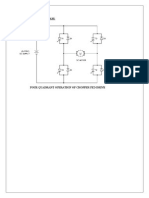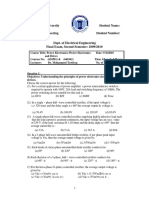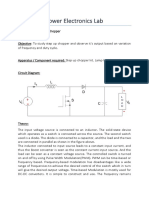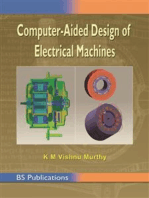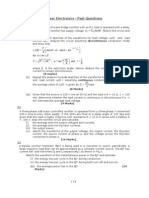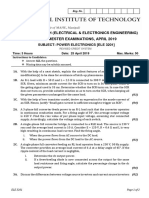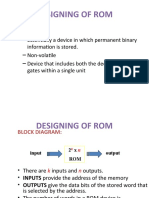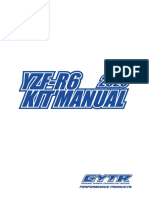Tutorial 3 - Phase Controlled AC-DC Converters
Uploaded by
ChangyuFuTutorial 3 - Phase Controlled AC-DC Converters
Uploaded by
ChangyuFuELEC4614
Power Electronics
University of New South Wales
School of Electrical Engineering & Telecommunications
Tutorial 3 Phase-controlled AC-DC Converters
1.
Derive the general expression for the DC output voltage of a p-pulse fully-controlled
converter, assuming continuous conduction and no overlap.
2.
Figure below shows a single-phase bridge DC supply to a large electromagnet installation,
such as the ones used for high temperature charged particle confinement chambers. The high
magnetic field implies a highly inductive load which keeps the load current smooth and
ripple-free. The AC supply voltage to the rectifier is 1414 V rms and the required magnet
current is 450 A. Calculate the firing angle required for this current.
[31.98]
If the magnetic field needs to be collapsed or brought down to zero quickly what would be
the smallest time, ignoring the overlap and the turn off time of the thyristors, in which this
would be possible?
[0.1536 sec]
R = 2.4
Vd
1414 V
Id
@ 50 Hz
L = 0.6 H
3.
A single-phase fully controlled thyristor bridge converter is supplied at 230 V, 50 Hz. The
supply source inductance is 0.9 mH/line. Neglecting the thyristor voltage drops and
assuming continuous conduction,
(i). plot a graph of load DC voltage Vd VS the firing angle for a load current of 35 A.
(ii). plot a graph of load DC voltage Vd VS load current IL up to 40 A DC for a firing
angle of = 30.
(iii). calculate the overlap angle for IL = 30 A and = 30.
[10.5]
4.
Compare the single-phase half-controlled and fully-controlled thyristor bridge converter
circuits in terms of their displacement, distortion, and power and factors. Assume the load
current to be smooth and ripple-free.
5.
A single-phase fully-controlled thyristor bridge converter is supplied from a 240V 50 Hz
supply.
(i) Calculate the power factor of the converter circuit at firing angles = 0 and 40,
when it supplies a smooth ripple free load current.
[0.9, 0.69]
(ii) Calculate the output DC voltage Vd when the firing angle = 135 and the overlap
angle is 10. Neglect thyristor voltage drops.
[- 164.9 V]
(iii) Plot the converter output voltage and one of the thyristor voltage waveforms for (ii).
Tutorial 3 Controlled AC-DC Rectifiers
F. Rahman/April 2010
ELEC4614
Power Electronics
6.
A three-phase, centre-tap converter has a free-wheeling diode across the load. Sketch the Vd
- characteristic of this converter and contrast this with the characteristic without the
freewheeling diode. Assume continuous conduction.
7.
A DC load requires control of Vd from maximum to 1/4 of the maximum value. If a half
controlled three-phase bridge is to be used, determine the current rating of the freewheeling
diode if the maximum load current is 20 A which is smooth and ripple free.
[14.14 A]
8.
A three-phase fully controlled bridge is supplied from a 415 V supply. Plot the Vd-
characteristic and sketch the load voltage waveforms at = 0, 30, 60, 90, 120 and
150.
9.
A three-phase fully controlled bridge supplies a smooth DC load current IL =100A.
(i) Calculate the required RMS and average current ratings of the thyristors. [33A, 58A]
(ii) Calculate the rms values of the total supply AC current and the fundamental supply
[82 A, 78 A]
current.
The converter is supplied from a 380 V, 50 Hz supply. For a Vd of 400 V, calculate
(iii) the input VA to the converter.
[53.97 kVA]
(iv) the required firing angle.
[39]
(v) If the input AC voltage varies by 8%, calculate the range of variation of the firing
angle so that Vd is kept constant.
[12]
Problems 10 and 11 are excluded for 2010.
10. Consider the regenerative converter of figure below. The load current is kept at a constant
level of 20 A. For the operating condition shown in the circuit, calculate the converter output
voltage, the firing angle and the overlap angle .
[105, 26]
van
vo
iL
0.01 H
T1
ia
vbn 0.01 H
ib
0.01 H
ic
T3
T5
R = 1
Vd
Load
L = 0.3 H
230V, 50 Hz
T4
vcn
T6
T2
160 V
(i) Sketch one of the input line currents indicating the transitions during the overlap angle.
(ii) Sketch one of the line-line AC input voltages to the converter indicating the
commutation notches.
Tutorial 3 Controlled AC-DC Rectifiers
F. Rahman/April 2010
ELEC4614
Power Electronics
11. A three-phase fully-controlled converter is supplied from a 415V, 50 Hz supply which has
source inductance of 1.2 mH per line. The converter is operated as an inverter with a firing
angle = 150 when the maximum load current is 50 A. Assuming the thyristor drop to be
1.6 volts for this load current, calculate
(i)
the output DC voltage
(ii)
the overlap angle
[-544.72 V]
[8.47]
(iii) the available recovery angle for the thyristors
[21.53]
(iv) the maximum load current that can be commutated at the above firing, allowing for a
minimum recovery angle of 5.
[101.2 A]
Tutorial 3 Controlled AC-DC Rectifiers
F. Rahman/April 2010
You might also like
- Basic Electrical Laboratory Manual: Department of Electrical EngineeringNo ratings yetBasic Electrical Laboratory Manual: Department of Electrical Engineering42 pages
- Corrig e TD5: Lelong J Er Ome 3 Janvier 2006No ratings yetCorrig e TD5: Lelong J Er Ome 3 Janvier 20065 pages
- Simulation of Some Power System, Control System and Power Electronics Case Studies Using Matlab and PowerWorld SimulatorFrom EverandSimulation of Some Power System, Control System and Power Electronics Case Studies Using Matlab and PowerWorld SimulatorNo ratings yet
- Arduino Multimeter and Components Tester - 4 StepsNo ratings yetArduino Multimeter and Components Tester - 4 Steps1 page
- Generation of High Voltage DC Using Diodes & Capacitors in Ladder NetworkNo ratings yetGeneration of High Voltage DC Using Diodes & Capacitors in Ladder Network6 pages
- Electrical Engineering and Simulation Lab ManualNo ratings yetElectrical Engineering and Simulation Lab Manual123 pages
- Power Semiconductor Devices ClassificationNo ratings yetPower Semiconductor Devices Classification9 pages
- 26.wireless Speed and Direction Control of DC Motor Using RF TechnologyNo ratings yet26.wireless Speed and Direction Control of DC Motor Using RF Technology3 pages
- Half-Wave Rectifier DC Motor With Freewheeling DiodeNo ratings yetHalf-Wave Rectifier DC Motor With Freewheeling Diode5 pages
- Pulse-Width Modulation (PWM) Techniques: Instructor: Prof. Ali KeyhaniNo ratings yetPulse-Width Modulation (PWM) Techniques: Instructor: Prof. Ali Keyhani35 pages
- Steady-State Equivalent Circuit Modeling, Losses, and EfficiencyNo ratings yetSteady-State Equivalent Circuit Modeling, Losses, and Efficiency20 pages
- MATLAB Based Analysis and Simulation of Multilevel InvertersNo ratings yetMATLAB Based Analysis and Simulation of Multilevel Inverters3 pages
- Design and Implementation of PID Controller For Motor Position Control100% (1)Design and Implementation of PID Controller For Motor Position Control5 pages
- Electrical Measurement & Instrumentation Course Outline: Text Book / Essential ReadingNo ratings yetElectrical Measurement & Instrumentation Course Outline: Text Book / Essential Reading3 pages
- Measurements and Instrumentation Unit 1No ratings yetMeasurements and Instrumentation Unit 162 pages
- Experiment No. 09: Single Phase Cyclo Converter100% (1)Experiment No. 09: Single Phase Cyclo Converter7 pages
- DC Motor Speed Control by Four Quadrant ChopperNo ratings yetDC Motor Speed Control by Four Quadrant Chopper12 pages
- ECE 3101 Industrial Electronics: Chopper DrivesNo ratings yetECE 3101 Industrial Electronics: Chopper Drives17 pages
- Power Electronics Lab Experiment-No. 6 Single-Phase Full and Half Wave Controlled SCR Rectifier Aim: To Study and Analyze The Properties and The Characteristics of A Single-PhaseNo ratings yetPower Electronics Lab Experiment-No. 6 Single-Phase Full and Half Wave Controlled SCR Rectifier Aim: To Study and Analyze The Properties and The Characteristics of A Single-Phase6 pages
- Servo Motor Interfacing With 8051 Using Keil Compiler100% (1)Servo Motor Interfacing With 8051 Using Keil Compiler11 pages
- Nptel: High Voltage DC Transmission - Web Course0% (1)Nptel: High Voltage DC Transmission - Web Course2 pages
- Multistring Five-Level Inverter With Novel PWMNo ratings yetMultistring Five-Level Inverter With Novel PWM13 pages
- Simulation of Power Electronic Systems Using PSpice PDF100% (1)Simulation of Power Electronic Systems Using PSpice PDF82 pages
- M.Tech: Power Electronics and Drives: Electrical Engineering DepartmentNo ratings yetM.Tech: Power Electronics and Drives: Electrical Engineering Department32 pages
- Experiment No. 05: RC Coupled Multistage CE-CC Cascade AmplifierNo ratings yetExperiment No. 05: RC Coupled Multistage CE-CC Cascade Amplifier5 pages
- Hearst Business Ethics Field Procedure 2014No ratings yetHearst Business Ethics Field Procedure 20144 pages
- LS (SSO) V5Series - Catalog - EN - 202104No ratings yetLS (SSO) V5Series - Catalog - EN - 20210424 pages
- Instant Download Blockchain and Cryptocurrency International Legal and Regulatory Challenges 1st Edition Dean Armstrong Kc PDF All ChaptersNo ratings yetInstant Download Blockchain and Cryptocurrency International Legal and Regulatory Challenges 1st Edition Dean Armstrong Kc PDF All Chapters45 pages
- wqd10202 Technicalmathii Complex Number PDFNo ratings yetwqd10202 Technicalmathii Complex Number PDF33 pages
- Case Study 4: The Collapse of Nokia's Mobile Phone BusinessNo ratings yetCase Study 4: The Collapse of Nokia's Mobile Phone Business26 pages







